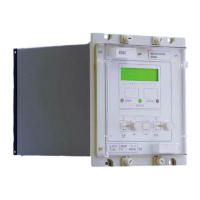Manual
KVCG202/EN M/H
2. HANDLING AND INSTALLATION
2.1 General considerations
2.1.1 Receipt of product
Although the product is generally of robust construction, careful treatment is required
prior to installation on site. Upon receipt, the product should be examined immediately, to
ensure no damage has been sustained in transit. If damage has been sustained during
transit, a claim should be made to the transport contractor, and a General Electric
representative should be promptly notified. Products that are supplied unmounted and not
intended for immediate installation should be returned to their protective polythene bags.
2.1.2 Electrostatic discharge (ESD)
The product uses components that are sensitive to electrostatic discharges.
The electronic circuits are well protected by the metal case and the internal module
should not be withdrawn unnecessarily. When handling the module outside its case, care
should be taken to avoid contact with components and electrical connections.
If removed from the case for storage, the module should be placed in an electrically
conducting antistatic bag.
There are no setting adjustments within the module and it is advised that it is not
unnecessarily disassembled. Although the printed circuit boards are plugged together,
the connectors are a manufacturing aid and not intended for frequent dismantling; in fact
considerable effort may be required to separate them.
Touching the printed circuit board should be avoided, since complementary metal oxide
semiconductors (CMOS) are used, which can be damaged by static electricity discharged
from the body.
2.2 Handling of electronic equipment
A person’s normal movements can easily generate electrostatic potentials of several
thousand volts. Discharge of these voltages into semiconductor devices when handling
electronic circuits can cause serious damage, which often may not be immediately
apparent but the reliability of the circuit will have been reduced.
The electronic circuits are completely safe from electrostatic discharge when housed in
the case. Do not expose them to risk of damage by withdrawing modules unnecessarily.
Each module incorporates the highest practicable protection for its semiconductor
devices. However, if it becomes necessary to withdraw a module, the precautions should
be taken to preserve the high reliability and long life for which the equipment has been
designed and manufactured.
Before removing a module, ensure that you are at the same electrostatic potential as the
equipment by touching the case.
Handle the module by its frontplate, frame or edges of the printed circuit board. Avoid
touching the electronic components, printed circuit track or connectors.
Do not pass the module to another person without first ensuring you are both at the same
electrostatic potential. Shaking hands achieves equipotential.
Place the module on an antistatic surface, or on a conducting surface which is at the
same potential as yourself.
Store or transport the module in a conductive bag.
If you are making measurements on the internal electronic circuitry of an equipment in
service, it is preferable that you are earthed to the case with a conductive wrist strap.
Wrist straps should have a resistance to ground between 500k–10M ohms.
If a wrist strap is not available, you should maintain regular contact with the case to
prevent a build-up of static. Instrumentation which may be used for making
measurements should be earthed to the case whenever possible.
More information on safe working procedures for all electronic equipment can be found in
BS5783 and IEC 60147–OF. It is strongly recommended that detailed investigations on

